Good for the Clinton campaign. The New York Times has completely lost it.
Dean Baquet Executive Editor The New York Times 620 Eighth Avenue New York, New York
July 28, 2015
Dear Mr. Baquet:
I am writing to officially register our campaign’s grave concern with the Times’ publication of an inaccurate report related to Hillary Clinton and her email use.
I appreciate the fact that both you and the Public Editor have sought to publicly explain how this error could have been made. But we remain perplexed by the Times’ slowness to acknowledge its errors after the fact, and some of the shaky justifications that Times’ editors have made. We feel it important to outline these concerns with you directly so that they may be properly addressed and so our campaign can continue to have a productive working relationship with the Times.
I feel obliged to put into context just how egregious an error this story was. The New York Times is arguably the most important news outlet in the world and it rushed to put an erroneous story on the front page charging that a major candidate for President of the United States was the target of a criminal referral to federal law enforcement. Literally hundreds of outlets followed your story, creating a firestorm that had a deep impact that cannot be unwound. This problem was compounded by the fact that the Times took an inexplicable, let alone indefensible, delay in correcting the story and removing “criminal” from the headline and text of the story.
To review the facts, as the Times itself has acknowledged through multiple corrections, the paper’s reporting was false in several key respects: first, contrary to what the Times stated, Mrs. Clinton is not the target of a criminal referral made by the State Department’s and Intelligence Community’s Inspectors General, and second, the referral in question was not of a criminal nature at all.
Just as disturbing as the errors themselves is the Times’ apparent abandonment of standard journalistic practices in the course of its reporting on this story.
First, the seriousness of the allegations that the Times rushed to report last Thursday evening demanded far more care and due diligence than the Times exhibited prior to this article’s publication.
The Times’ readers rightfully expect the paper to adhere to the most rigorous journalistic standards. To state the obvious, it is hard to imagine a situation more fitting for those standards to be applied than when a newspaper is preparing to allege that a major party candidate for President of the United States is the target of a criminal referral received by federal law enforcement.
This allegation, however, was reported hastily and without affording the campaign adequate opportunity to respond. It was not even mentioned by your reporter when our campaign was first contacted late Thursday afternoon. Initially, it was stated as reporting only on a memo – provided to Congress by the Inspectors General from the State Department and Intelligence Community – that raised the possibility of classified material traversing Secretary Clinton’s email system. This memo – which was subsequently released publicly – did not reference a criminal referral at all. It was not until late Thursday night – at 8:36 pm – that your paper hurriedly followed up with our staff to explain that it had received a separate tip that the Inspectors General had additionally made a criminal referral to the Justice Department concerning Clinton’s email use. Our staff indicated that we had no knowledge of any such referral – understandably, of course, since none actually existed – and further indicated that, for a variety of reasons, the reporter’s allegation seemed implausible. Our campaign declined any immediate comment, but asked for additional time to attempt to investigate the allegation raised. In response, it was indicated that the campaign “had time,” suggesting the publication of the report was not imminent.
Despite the late hour, our campaign quickly conferred and confirmed that we had no knowledge whatsoever of any criminal referral involving the Secretary. At 10:36 pm, our staff attempted to reach your reporters on the phone to reiterate this fact and ensure the paper would not be going forward with any such report. There was no answer. At 10:54 pm, our staff again attempted calling. Again, no answer. Minutes later, we received a call back. We sought to confirm that no story was imminent and were shocked at the reply: the story had just published on the Times’ website.
This was, to put it mildly, an egregious breach of the process that should occur when a major newspaper like the Times is pursuing a story of this magnitude. Not only did the Times fail to engage in a proper discussion with the campaign ahead of publication; given the exceedingly short window of time between when the Times received the tip and rushed to publish, it hardly seems possible that the Times conducted sufficient deliberations within its own ranks before going ahead with the story.
Second, in its rush to publish what it clearly viewed as a major scoop, the Times relied on questionable sourcing and went ahead without bothering to seek corroborating evidence that could have supported its allegation.
In our conversations with the Times reporters, it was clear that they had not personally reviewed the IG’s referral that they falsely described as both criminal and focused on Hillary Clinton. Instead, they relied on unnamed sources that characterized the referral as such. However, it is not at all clear that those sources had directly seen the referral, either. This should have represented too many “degrees of separation” for any newspaper to consider it reliable sourcing, least of all The New York Times.
Times’ editors have attempted to explain these errors by claiming the fault for the misreporting resided with a Justice Department official whom other news outlets cited as confirming the Times’ report after the fact. This suggestion does not add up. It is our understanding that this Justice Department official was not the original source of the Times’ tip. Moreover, notwithstanding the official’s inaccurate characterization of the referral as criminal in nature, this official does not appear to have told the Times that Mrs. Clinton was the target of that referral, as the paper falsely reported in its original story.
This raises the question of what other sources the Times may have relied on for its initial report. It clearly was not either of the referring officials – that is, the Inspectors General of either the State Department or intelligence agencies – since the Times’ sources apparently lacked firsthand knowledge of the referral documents. It also seems unlikely the source could have been anyone affiliated with those offices, as it defies logic that anyone so closely involved could have so severely garbled the description of the referral.
Of course, the identity of the Times’ sources would be deserving of far less scrutiny if the underlying information had been confirmed as true. However, the Times appears to have performed little, if any, work to corroborate the accuracy of its sources’ characterizations of the IG’s referral. Key details went uninvestigated in the Times’ race to publish these erroneous allegations against Mrs. Clinton. For instance, high in the Times’ initial story, the reporters acknowledged they had no knowledge of whether or not the documents that the Times claimed were mishandled by Mrs. Clinton contained any classified markings. In Mrs. Clinton’s case, none of the emails at issue were marked. This fact was quickly acknowledged by the IC inspector general’s office within hours of the Times’ report, but it was somehow left unaddressed in the initial story.
Even after the Times’ reporting was revealed to be false, the Times incomprehensibly delayed the issuance of a full and true correction.
Our campaign first sought changes from the Times as soon as the initial story was published. Recognizing the implausibility that Mrs. Clinton herself could be the subject of any criminal probe, we immediately challenged the story’s opening line, which said the referral sought an investigation into Mrs. Clinton specifically for the mishandling of classified materials. In response, the Times’ reporters admitted that they themselves had never seen the IG’s referral, and so acknowledged the possibility that the paper was overstating what it directly knew when it portrayed the potential investigation as centering on Mrs. Clinton. It corrected the lead sentence accordingly.
The speed with which the Times conceded that it could not defend its lead citing Mrs. Clinton as the referral’s target raises questions about what inspired its confidence in the first place to frame the story that way. More importantly, the Times’ change was not denoted in the form of a correction. Rather, it was performed quietly, overnight, without any accompanying note to readers. This was troubling in its lack of transparency and risks causing the Times to appear like it is trying to whitewash its misreporting. A correction should have been posted promptly that night.
Regardless, even after this change, a second error remained in the story: the characterization of the referral as criminal at all. By Friday morning, multiple members of the House Committee on Oversight and Government Reform (who had been briefed by the Inspectors General) challenged this portrayal-and ultimately, so did the Department of Justice itself. Only then did the Times finally print a correction acknowledging its misstatement of the nature of the referral to the Justice Department.
Of course, the correction, coming as it did on a Friday afternoon, was destined to reach a fraction of those who read the Times’ original, erroneous report. As the Huffington Post observed:
“…it’s unlikely that the same audience will see the updated version unless the paper were to send out a second breaking news email with its latest revisions. The Clinton story also appeared [on] the front page of Friday’s print edition.”
Most maddening of all, even after the correction fixed the description of the referral within the story, a headline remained on the front page of the Times’ website that read, “Criminal Inquiry is Sought in Clinton Email Account.” It was not until even later in the evening that the word “criminal” was finally dropped from the headline and an updated correction was issued to the story. The lateness of this second correction, however, prevented it from appearing in the paper the following morning. We simply do not understand how that was allowed to occur.
Lastly, the Times’ official explanations for the misreporting is profoundly unsettling.
In a statement to the Times’ public editor, you said that the errors in the Times’ story Thursday night were “unavoidable.” This is hard to accept. As noted above, the Justice Department official that incorrectly confirmed the Times’ initial reports for other outlets does not appear to have been the initial source for the Times. Moreover, it is precisely because some individuals may provide erroneous information that it is important for the Times to sift the good information from the bad, and where there is doubt, insist on additional evidence. The Times was under no obligation to go forward on a story containing such explosive allegations coming only from sources who refused to be named. If nothing else, the Times could have allowed the campaign more time to understand the allegation being engaged. Unfortunately, the Times chose to take none of these steps.
In closing, I wish to emphasize our genuine wish to have a constructive relationship with The New York Times. But we also are extremely troubled by the events that went into this erroneous report, and will be looking forward to discussing our concerns related to this incident so we can have confidence that it is not repeated in the future.
Sincerely,
Jennifer Palmieri Communications Director Hillary for America
Cc: Margaret Sullivan, Public Editor New York Times

 Seriously, the Webb campaign is touting its support from someone basically no Democrat – obviously, we’re not counting LIE-berman’s pals’ John McCain and Lindsey Graham here – likes. And for good reason. Consider that LIEberman
Seriously, the Webb campaign is touting its support from someone basically no Democrat – obviously, we’re not counting LIE-berman’s pals’ John McCain and Lindsey Graham here – likes. And for good reason. Consider that LIEberman 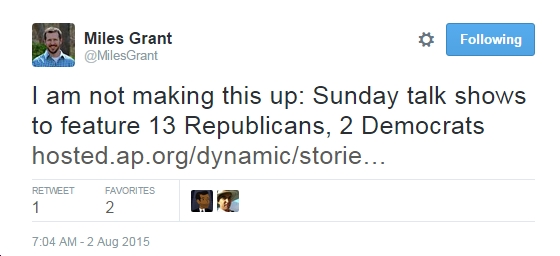
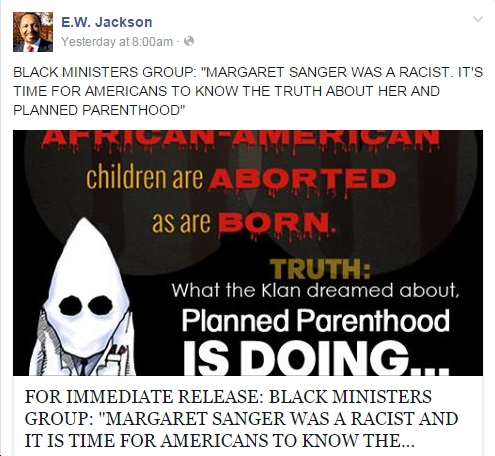 It will never cease to amaze me that E.W. Jackson, a crazy person and also someone who’s as extreme as you can get in this country, was the 2013 Virginia GOP’s nominee for Lt. Governor of our state. Jackson’s constant ravings are disturbing, although amusing in a twisted way. But
It will never cease to amaze me that E.W. Jackson, a crazy person and also someone who’s as extreme as you can get in this country, was the 2013 Virginia GOP’s nominee for Lt. Governor of our state. Jackson’s constant ravings are disturbing, although amusing in a twisted way. But 
 For anyone who thinks that the Clean Power Plan (coming out Monday) specifically, and transitioning from dirty to clean energy generally, are “bad for business,” they might first want to talk to the
For anyone who thinks that the Clean Power Plan (coming out Monday) specifically, and transitioning from dirty to clean energy generally, are “bad for business,” they might first want to talk to the 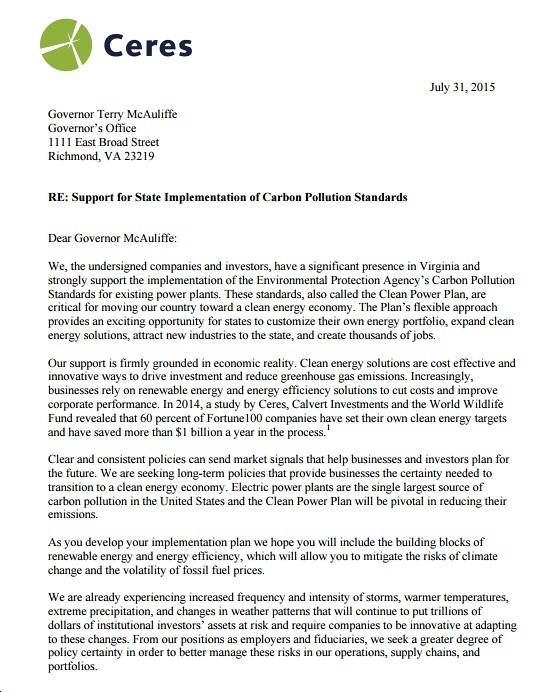
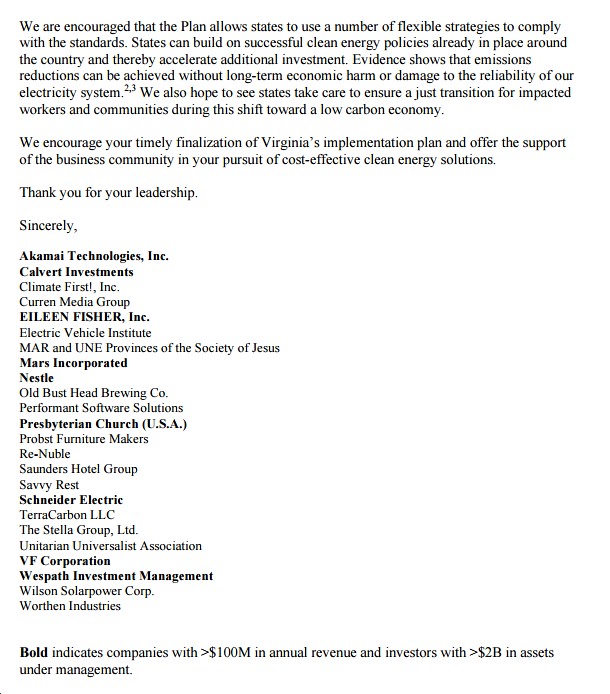
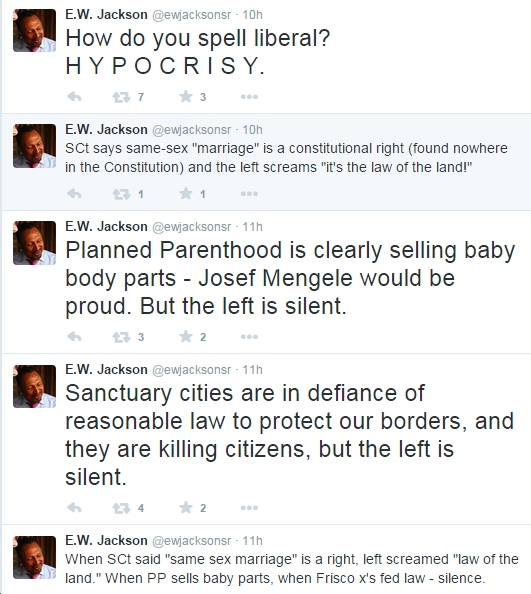 Here are a few national and Virginia news headlines, political and otherwise, for Friday, July 30. And yes, as you can see from his tweets, 2013 Virginia GOP Lt. Gov. nominee E.W. Jackson is STILL off his meds. Sad.
Here are a few national and Virginia news headlines, political and otherwise, for Friday, July 30. And yes, as you can see from his tweets, 2013 Virginia GOP Lt. Gov. nominee E.W. Jackson is STILL off his meds. Sad.



![Sunday News: “Rightwing settlers in Israel welcome [Trump] ‘dream team’”; “Trump’s Team Of Rejects Will Lead Us To Disaster”; “Anxiety And Dismay Inside [DoJ]”; “As Trump’s plans become clearer, reject these four dangerous ideas”; Congrats to Kannan Srinivasan](https://bluevirginia.us/wp-content/uploads/2024/11/montage1117-100x75.jpg)
